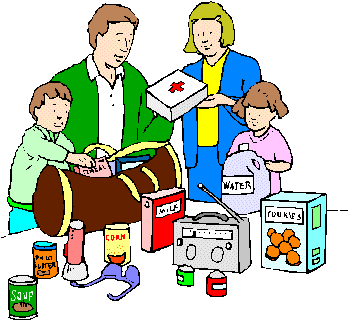Middle school students appear to have some sort of fascination with natural disasters - as long as the disaster is being shown on a film clip. I found that natural disasters require a three pronged approach - science, preparedness, and response.
The science of natural disasters is evolving every day. Scientists of all kinds have been investigating and studying the mechanisms of various disasters, from earthquakes to tornadoes. We have a better understanding of the factors that invariably lead to the disaster, from locations of faults to weather conditions. Because of this, we are more likely to be warned of the impending disaster. There are warning systems for just about every possible scenario, except for earthquakes or rogue asteroids that have been hiding in the shadows.

My students require skills to understand and analyze the information that is available, as well as how it applies to them. Learning about volcanoes can be fun. However, the reason that volcanism is part of the curriculum is because it can impact the lives of my students. Wait.....I live in Georgia. How does a volcano affect me? This is a question that I often hear. I often use the supervolcano at Yellowstone National Park as an example. Even though the East Coast will most likely be spared immediate damage, the volcanic ash will eventually travel to Georgia via the winds, causing various problems. There will be disturbances to the student's daily lives (ash finding its way into car engines, etc.) as well as food shortages. Making those connections is a vital step in making our students scientifically literate learners.

Being prepared is not just for Boy Scouts. Having basic supplies, such as batteries or bottled water, could mean survival during a natural disaster. I stress to my students how important it is to have a Emergency Preparedness Kit at home. One assignment my students undertake is to create their own kit. Not only do they add supplies, but they also have to explain why the item is important. This often leads to discussion. Many of my students will add a flashlight, but no batteries. Completing this activity requires the students to extend their thinking in a manner that is rigorous and relevant.

Middle school students are notorious for being self absorbed, so it is vital that they learn the importance of responding in the wake of a natural disaster. Every year, the school has canned food drives. However, the students are usually disinclined in assisting in the drive unless there is some sort of reward attached. Even though the canned food stays in the community, there is no personal connection. However, I observed a different type of middle schooler last year. Last spring, there was a massive outbreak of tornadoes in the South, including Georgia. There were at least two areas in the city that I teach in that was affected - one area includes the district that feeds into my school. Students that walked the halls of the school had lost their homes, their clothes, and even relatives. The school quickly began to collect personal items and clothes that could be disseminated into the community through the Salvation Army and other local charities. We had an empty classroom that was filled with clothes, toothpaste, and toilet paper. The children did not ask if they would receive a reward - they were just happy to help.

Cultivating the desire to help others is a necessity. Students must learn that assisting others does not always benefit them directly, but it does benefit the community as a whole.




Denise,
ReplyDeleteThanks so much for the very informative post. I love the lessons you teach your students about preparedness and compassion. It is absolutely true what you say about most middle school kids being self absorbed, that is until something strikes their community or loved ones. I have seen the hearts of these kids open up when something tragic occurs in our community as well. I know that a lot of times it takes something disastrous to speak to the heart of these kids, but it is always one of our goals as educators to try and teach our students the importance of compassion and charity, whether or not their efforts benefit others locally or globally.
Julius Dichosa
Hello,
DeleteI also wanted to say thank you for the wonderful post! I agree that in many cases students are self-absorbed, but I also think that it is possible to reach students and engage them to reach out to others outside of their community as well. I wanted to recommend a website that is targeted to middle school/ high school students to help them take action at:
http://www.dosomething.org/
Amy :)